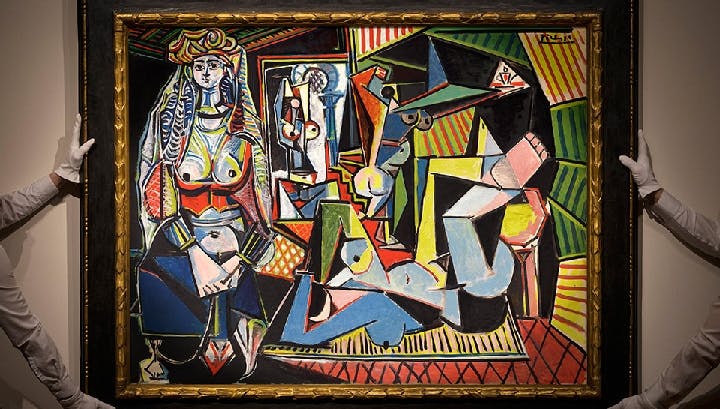The Disappearing Act of the World’s Most Valuable Art
– Nicole Orttung
Sold to anonymous bidders and quiet buyers, classical masterpieces often go into hiding for years at a time. The art market has been operating with minimal transparency or oversight for years – dragging treasured artwork from the spotlight to the shadows.
Earlier this year, Pablo Picasso’s Les Femmes d’Alger (Version O) fetched the highest price ever for a work of art at a public auction: $179 million. An auctioneer declared the painting “the most important Picasso after the war,” while a critic described it as an absurdly overpriced work lacking the “fire of genius” of Picasso’s earlier pieces.
You will probably never get to see it in person and judge for yourself. The anonymous buyer will likely keep the work safely locked away, protected from the flash of tourists’ cameras or risk of thievery.
The Geneva Freeport advertises itself as just the place for that famed Picasso, and thousands of other valuable works of art. If it were a museum, it would probably be “the best museum in the world,” asserts Jean-Rene Saillard, director of Geneva’s Fine Art Fund Group. Instead, the Geneva Freeport is a state-of-the-art storage facility, guaranteeing optimal conditions and security for the valuables it houses. Also enticing is the fact that free ports, zones with relaxed regulations for goods in transit, are exempt from customs and taxes.
Conveniently, there is no timeline requiring these goods “in transit” to leave their secure vaults — ever — and goods can change hands within the facilities, also tax-free. There could be as much as $100 billion worth of art stored in the Geneva Freeport, though that information isn’t publicly available (secrecy is another key selling point of the facility).
In the context of growing wealth inequality and mistrust of traditional financial assets, the global art market has been booming in recent years — particularly for the most expensive pieces. A record-breaking €51 billion was spent on art last year, according to the European Fine Art Foundation. Yet the market is not as healthy as the impressive numbers might suggest.
In an article entitled “Explaining the Art Market’s Thefts, Frauds, and Forgeries (And Why the Art Market Does Not Seem to Care),” Gregory Day explores the secretive state of the art market today, where all the players involved are incentivized to reveal as little information as possible. Rather than striving towards an efficient market, where resources are allocated according to widely available information, buyers, sellers, auctioneers, and private dealers seem to have agreed to deal in the dark — and there’s no government regulation to stop them.
At first glance, it’s unbelievable that buyers are willing to shell out millions for an item with uncertain value. As a unique good, art doesn’t have a “going rate” to serve as a benchmark, so a dealer’s asking price begins the conversation. Auction houses, as public venues where experts can view and weigh in on the work, should add more validity to the price, but bidders are often anonymous, and it’s common practice for sellers to hire agents to bid up prices.
About half of art sales take place in private deals, where dealers are allowed to represent both the sellers and buyers without disclosing this conflicting interest to either party. In such a situation, the dealer clearly would have little interest in finding a “fair value,” questioning the work’s authenticity, or looking into whether or not it had been stolen in the past, which would give someone else a claim to it. These concerns, which are central to determining the value of an artwork, are rarely adequately addressed.
Day explains that “the norms of the art world [instruct] dealers and buyers to refrain from questioning a work’s origin and transactional history,” which is remarkable considering that when a work’s authenticity is called into dispute, its value plummets, and works that have been stolen typically must be returned to their rightful owner, no matter when the thievery took place.
Buyers are willing to refrain from asking these questions precisely because they consider their purchased art as an investment — an asset they will sell at an opportune time. They adopt the seller’s perspective; doubts that could diminish the price tag are pushed aside under the assumption that no one later down the line will bring up the issue either.
Investigating the history of a work at art is expensive and challenging, partly because of the difficulty of finding a disinterested expert. Specialists who own works by a particular artist are wary of authenticating other works by the same artist, since they could drive down the value of their own holdings. Experts can stand to lose from questioning the authenticity of a work: some owners have been known to sue them for threatening the work’s marketability.
The current legal regime is ill-suited to monitoring the art market, requiring “a level of information that almost never exists,” according to Day. Considering the art world’s long history of undisclosed ownership and sketchy record-keeping — and the fact that nearly half of Europe’s art was stolen during WWII — virtually all artwork has a disputable past. Since neither buyers nor sellers expect to meet legal standards, they push negotiations farther underground.
No one seems keen on changing the shadowy status quo. The interests of buyers and sellers are sufficiently aligned, for a buyer expects to benefit more as a seller tomorrow than she risks losing as a buyer today. After all, art tends to gain value as it hangs on the wall, or sits in storage, as the case may be.
* * *
The Source: Gregory Day, “Explaining the Art Market’s Thefts, Frauds, and Forgeries (And Why the Art Market Does Not Seem to Care,” Vanderbilt Journal of Entertainment and Technology Law 3.16 (2014).
Photo courtesy of Christies
